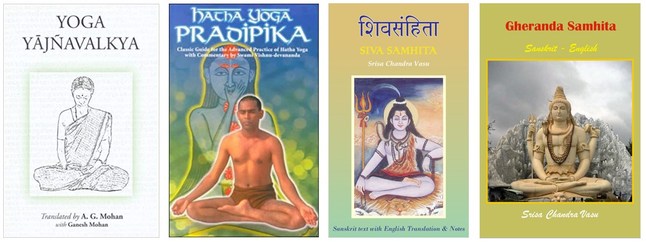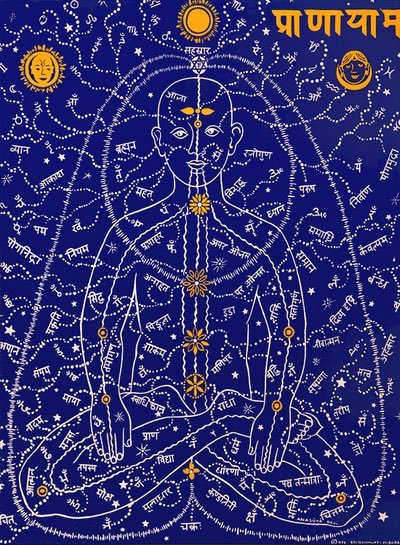What is Hatha Yoga?

The ancient hatha yoga texts (Yoga Yajnavalkya1, Hatha Yoga Pradipika2, Siva Samhita3 and Gheranda Samhita4) describe techniques and practices that have a universal benefit on the human body, energy system, mind and psyche. They are practice manuals, not theological treatises. This may explain hatha yoga’s popularity. It is open to all.
Yoga
Many see yoga as an activity, but it actually describes a state where one experiences complete vitality, mental clarity, and joy (sat-chid-ananda) where the deepest aspect of our personal self expands into what can only be described as divine consciousness. It is a natural condition not dependent upon anything external to us and connects us to all life with a feeling of love and empathy.
According to ancient tradition, there are four main paths to attain this state of yoga:
- Karma Yoga - transforming one's actions
- Bhakti Yoga - transforming one's emotions
- Jnana Yoga - transforming one's intellect
- Raja Yoga - transforming one's mind
In the Hatha Yoga Pradipika, it states that Hatha Yoga is “a ladder to those who wish to attain the lofty Raja Yoga.”5.
It is also said that there can be no Raja Yoga without Hatha Yoga and no Hatha Yoga without Raja Yoga.
Raja Yoga
In Raja Yoga, referred to as the science of the mind, we recognize that we are not the mind. There is a deeper aspect of ourselves which governs the mind and directs it to follow our higher intelligence. When we are diligent to stay connected to our deepest self, we practice Raja Yoga where we work directly on the mind to reduce its fluctuations so we come to that natural state of divine consciousness.
While Raja Yoga speaks of eight practical steps, it mainly refers to the practice of mental concentration where one makes an effort to maintain the mind focussed on an object, meditation where effort is no longer needed, and a state of absorption where one feels no separation from the object of focus.
However, as the mind behaves like a wild horse extremely difficult to rein in, it can prove difficult to succeed with mental concentration, so one practices Hatha Yoga to tame the mind until its refinement through Raja Yoga becomes possible.
Due to our strong identification with the mind, we have a tendency to forget our deepest self and become a slave to the mind allowing its thoughts to influence our emotions and behavior. Imagine, for instance, that you harbor a thought that provokes the feeling of anger. This anger will agitate your natural breathing which in turn will intensify the anger. The thought has seized power over you, and you are no longer able to control it. No clear thinking can take place. There is suddenly a tendency to react impulsively in a way that we know does not bring about the best outcome. Instead, it brings us into trouble.
If we are powerless to move on from this anger-producing thought using Raja Yoga, we can intercede with the breath using Hatha Yoga to bring the mind back to its proper relationship with our deepest self. In a way, Hatha Yoga is the suggestion to take ten deep breaths before acting!
With Hatha Yoga, we work indirectly on the mind by focussing on the purification and channeling of life force energy (prana) within our energy system, the pranamaya kosha.
A Focus on Prana

© 1972 Sri Ramamurti Mishra
The life force energy Prana exists everywhere both within and without the body. External sources include the sun, air, water, food, walking barefoot on the earth, and uplifting social contact.
Within one’s energy system, Prana circulates in 10 principle ways, 5 of which are considered important with two (prana & apana) most important:
- prana – upward flowing energy associated with inhalation
- apana – downward flowing energy associated with exhalation and expulsion (reproduction and elimination)
- samana – digestive energy governing assimilation and absorption
- udana – energy centered in the throat governing expression and communication, also involved with the upward flow of kundalini.
- vyana – systemic energy throughout the body governing circulation
Prana flows through energy channels (nadis). The ancient hatha texts claim there are 72,000 nadis but consider 3 most important (ida, pingala, and sushumna).
The upward flowing prana is represented by the “ha” in “hatha”. It is associated with the pingala nadi along the right side within the spine terminating at the right nostril. The downward flowing apana is represented by the “tha” in “hatha”. It is associated with the ida nadi along the left side within the spine terminating at the left nostril. Often, these two nadis are depicted as spiraling and intersecting at six points.
When the brain’s creative right hemisphere is dominant, the left ida nadi is more active. Air flows more readily through the left nostril. When the brain’s analytical left hemisphere is dominant, the right pingala nadi is more active. According to Swara yoga6, either ida or pingala is more active every 90-120 minutes.
While these energy currents alternate, we experience the concepts of time, space, and ego. However, the great rishis of hatha yoga discovered that through purification of the nadis (nadi shodhana) and concentration (dharana), we can equilibrate the nadis' flow where the currents no longer alternate. The prana and apana forces flow together through the sushumna nadi directly between ida and pingala and are retained there through bandhas and mudras in a way where the energy is intensified until it sparks the awakening of the spiritual power of kundalini shakti which leads to an ecstatic state of transcendence. There is no longer the feeling of time, space and ego. One enters a state of eternity, infinity, and divine consciousness.
Awakening and Rise of Kundalini
The aim of Hatha Yoga is this joining together of prana and apana within the sushumna nadi. As one advances, the yoga postures and sequencing remain the same, but the hatha yogi takes on a deeper, more intense inner focus within the energetic realm.
Where nadis cross are hubs or vortexes (chakras) of energy. While the ancient texts claim there are 72,000 nadis, there are even more chakras with seven chief chakras aligned vertically within the sushumna nadi at points where ida and pingala are said to intersect.
Some say that kundalini rises within the sushumna. Others say that it is “burnt” allowing the conjoined prana-apana to rise. In either case, internal blockages or knots (granthis) of vitality (Brahma granthi), emotion (Vishnu granthi), and thought (Rudra granthi) are dissolved as this energy rises through the main chakras. It is a union depicted symbolically as a marriage between Sakti (pure energy) who journeys from the base of the spine and Siva (pure consciousness) who resides at the crown of the head (the Brahmarudhra).
Hatha Yoga
Working with the energy system brings tremendous power. Before starting, the hatha yogi abides by certain ethical restraints (yamas) and ethical observances (niyamas) to ensure that this power is deployed in a beneficial manner both for the practitioner and the world. They are also the first steps toward adhering the mind to the will of our deepest self.
Then, the hatha yogi practices:
- kriyas - purification techniques
- asanas - yoga postures
- pranayama - breathing techniques
- mudras - energy seals
- bandhas - energy locks
- pratyahara - directing the senses inwardly
- dharana - concentration
- dhyana - meditation
- samadhi - absorption
While hatha yoga describes an almost mechanistic approach to the awakening and ascent of kundalini, all forms of yoga (karma, bhakti, jnana) have a signifcant influence over kundalini shakti. For instance, cultivating the feeling of unconditional love in bhakti yoga naturally awakens kundalini without the practitioner’s focus on it.
Yoga Postures
While yoga asanas make one strong and flexible and balance the endocrine and nervous systems, the hatha yogi views asana in terms of nadi purification to facilitate the joining of prana and apana in the sushumna for its subsequent rise.
The Hatha Yoga Pradipika mentions 84 postures with eight most important. The eight are mainly seated postures that allow the yogi to remain stable and comfortable to carry out the higher hatha practices of pranayama, pratyahara, concentration and meditation.
The ancient hatha texts also mention other postures found in contemporary yoga: the sitting forward bend posture paschimottanasana, the backward bending “bow” posture dhanarasana, the arm balancing “peacock” posture mayurasana, and the spinal twisting posture matsendrasana.
Nada
As one progresses in hatha yoga, one’s inner life takes on a richness that draws the senses inward (pratyahara). Together, the senses concentrate the mind where it begins to discern inner sound vibration (nada). This focus is delicate and transforms our state of consciousness. From it, our mind approaches pure silence where the expansion into divine consciousness can take place.
For this reason, we do not play music in our courses. External stimuli, no matter how pleasant, conflict with the intensification and deepening of this subtle inner focus. A mind oscillating back and forth between internal and external stimuli is not concentrated enough to settle deeper into higher meditative states.
That said, when music becomes the mind’s solitary focus, like in Nada Yoga, it guides concentration toward meditation. In Nada Yoga, one consciously listens to musical notes in the Indian scale which resonate on a vibratory level with the chakras. One also repeats mantras which are sound vibrations that protect the mind (manas=mind, tra=protect). Mantras quell indiscriminate thought activity and bring us closer to that mental silence conducive to meditative states.
Hatha Yoga Lineages
Sivananda Yoga, Ashtanga Vinyasa Yoga, Iyengar Yoga, and Vinyasa Krama are four systems of Hatha Yoga taught at La Source. Each system has developed through a specific lineage: the first through Sivananda Saraswati of Rishikesh by his disciple Swami Vishnudevananda and the last three through Krishnamacharya of Mysore by his disciples Pattabhi Jois, BKS Iyengar and Srivatsa Ramaswami respectively.
When you come to any of our hatha yoga courses, they will include the structured posture sequence of that specific hatha system. Some will include pranayama breathing exercises. Others may not include pranayama as a stand-alone practice but will focus your attention to the breath to regulate the prana and to intensify concentration. Some teachers may include meditation.
There are many more Hatha Yoga systems which are either named after the master of that hatha system or after a yogic concept to set it apart.
Where you find classes generically named “hatha yoga”, the teacher is either not certified through a specific lineage or is certified but chooses not to adhere to that lineage’s structured sequencing of yoga postures. The teacher may wish to come up with his/her own sequence of the classic postures or create a sequence that will suit the specific needs of the students.
Bibliography
- Yoga Yajnavalkya, commentaries by A.G. Mohan
- Hatha Yoga Pradipika, commentaries by Swami Vishnudevananda
- Siva Samhita, commentaries by Srisa Chandra Vasu
- Gheranda Samhita, commentaries by Srisa Chandra Vasu
- Hatha Yoga Pradipika, commentaries by A.G. Mohan
- Swara Yoga, Swami Muktibodhananda


